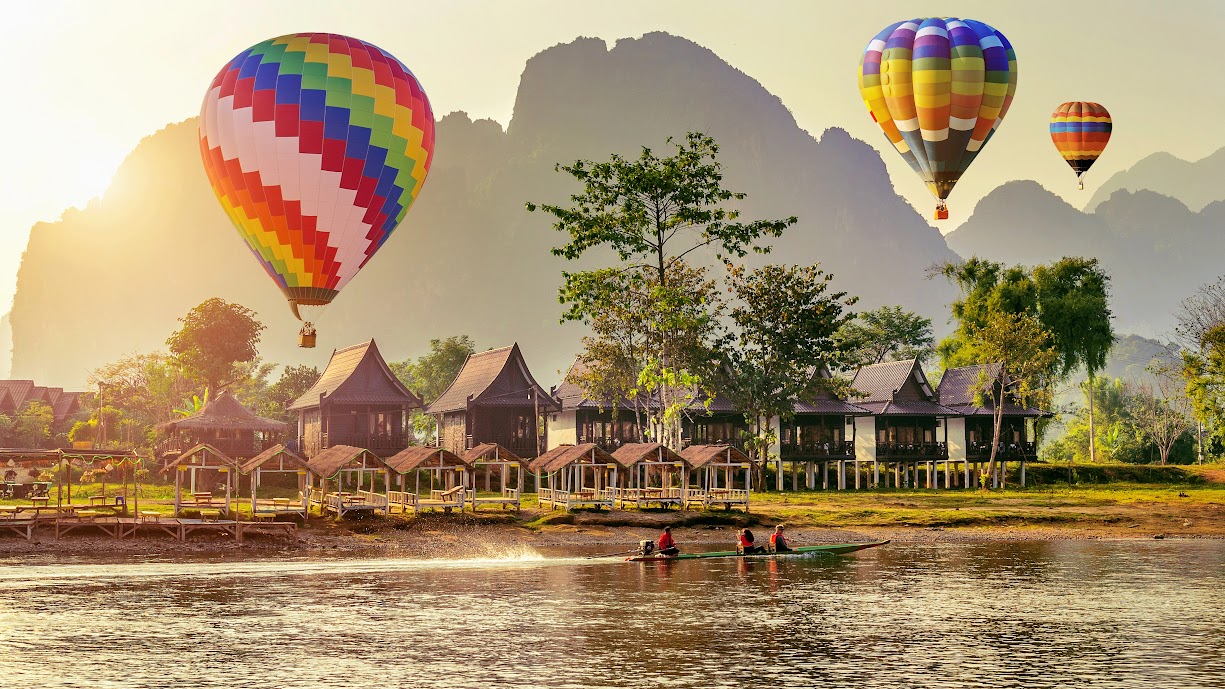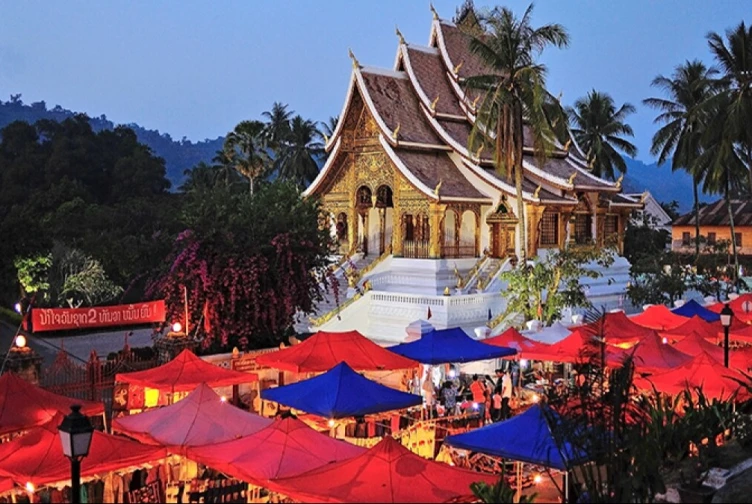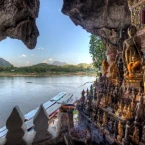
Best Time To Visit Laos: Weather & Tips
Content []
Known for its stunning landscapes, rich cultural heritage, and warm hospitality, Laos offers something special in every season. Auasia Travel will accompany you to discover the best times to experience this enchanting country at its finest.
Table of Contents
1. When is the best time to visit Laos
The best time to visit Laos is from November to February, when the weather is cool, dry, and most pleasant throughout the year. This is the dry season in Laos, with clear skies, little to no rain, and temperatures ranging from 20°C to 28°C - perfect for exploring cities, visiting ancient temples, enjoying the countryside, trekking, taking boat rides along the Mekong River, or joining traditional festivals.
Laos has two distinct seasons: the dry season, which lasts from November to early May, and the rainy season, which runs from late May through October. While the dry season is the most popular time for tourism, the countryside is at its most vibrant and lush right after the rains, especially in October - when rice paddies turn bright green and waterfalls are at their most impressive. However, from July to September, heavy rainfall is common and can occur daily, so visitors during this period should be prepared for wet conditions.
In Northern Laos, particularly in Luang Prabang, the climate remains warm year-round, but the most comfortable period is December and January. This is when the dry season brings cool and pleasant temperatures, ideal for sightseeing and outdoor adventures. March and April can be extremely hot and humid, making it more difficult to enjoy the heat of the day. The rainy season from late May to October typically brings short afternoon showers, so mornings remain ideal for exploration.
In the South, especially in the capital Vientiane, the climate tends to be hotter than in the North. The best time to visit Vientiane is also from November to February, when sunny days and mild temperatures create ideal conditions for exploring the city and its surroundings.
From March to May, temperatures rise sharply, often reaching 38°C, accompanied by high humidity, making outdoor activities more challenging. The rainy season extends from June through October, and although it’s less busy with tourists, the landscape becomes greener and more serene - great for those who don’t mind occasional downpours.
2. What the Weather in Laos
Laos Weather in January January
January is a wonderful time to begin your journey. You’ll be welcomed by clear blue skies, warm sunshine, and pleasant weather. The average temperature in Vientiane and Luang Prabang hovers around 24°C, making it perfect for walking tours of historical sites, exploring local markets, or strolling along the riverside.
In the south, especially in areas like Pakse and the 4000 Islands, the weather is slightly warmer, with daytime temperatures reaching up to 30°C. If you plan to visit the mountainous regions in the north or stop in Pakbeng during a Mekong River cruise, be prepared with a light jacket as nighttime temperatures can drop to around 15°C.
Laos Weather in February

Moving into February, the weather remains largely the same as in January, making it a good time to travel to Laos. The conditions are still dry and cool, with plenty of sunshine. Temperatures in Vientiane and Luang Prabang stay comfortably around 24°C, while Pakse and the southern regions continue to experience slightly warmer temperatures of about 30°C.
February is also a popular month for tourists because of the favorable weather, perfect for outdoor activities and exploring the natural beauty of the country.
Laos Weather in March
By March, temperatures begin to rise noticeably. Laos enters its first hot spell of the year, with temperatures in Vientiane and Luang Prabang often exceeding 30°C, and reaching up to 32°C in Pakse and the 4000 Islands region.
Although it is still the dry season, the heat can make midday sightseeing quite tiring. It’s advisable for travelers to start their tours early in the morning and take a break from around 11 a.m. to 3 p.m. to avoid the hottest part of the day. This is also an ideal time to visit the Bolaven Plateau in the south, where the higher elevation offers cooler weather, as well as beautiful waterfalls and lush coffee plantations.
Laos Weather in April
April is the hottest month of the year in Laos. Daytime temperatures in many areas can reach up to 40°C, particularly in the southern regions like Pakse and the 4000 Islands. In Vientiane and Luang Prabang, the average temperature is around 30°C, but the heat feels more intense due to increased humidity.
However, by the end of April, you may begin to experience the first rains of the season, especially in the northern mountainous areas like Phongsali. These rain showers are usually short-lived and unlikely to significantly affect your travel plans.
Weather in Laos in May
The first half of May is usually relatively dry; however, the rainy season starts to appear later in the month. Short and heavy showers generally do not significantly affect your trip as they are quickly replaced by clear skies and sunshine. In the southern regions, rain showers may last longer.
If you can avoid the rain as much as possible, May can be a wonderful time to visit Laos, with the added advantage of much fewer tourists compared to the previous months, allowing for a more peaceful and relaxed experience.
Weather in Laos in June
June marks the beginning of the rainy season in Laos but is still considered a good month for sightseeing. You can expect warm sunshine and clear skies in between heavy showers, which usually last only a few hours rather than the entire day.
Rainfall tends to be heavier at higher elevations, while riverside towns in southern Vientiane receive the least rain. Average temperatures range from 25 to 27°C, with Pakse being warmer than Luang Prabang and Vientiane, and Phongsali in the north enjoying slightly cooler conditions.
Weather in Laos in July

If you travel to Laos in July, be prepared for heavy rain. However, these downpours typically last just a few hours rather than all day, and there are still many dry days to explore.
In Pakse and the southern regions, rainfall is often more intense and prolonged, which means the waterfalls in the 4000 Islands area are at their most spectacular. Despite overcast skies, average temperatures in Luang Prabang and Vientiane hover around 25-27°C.
Weather in Laos in August
August is the peak of the rainy season in Laos, with heavy rain almost daily. Although the skies are mostly cloudy, average temperatures in Luang Prabang and Vientiane remain between 25 and 30°C. Showers in Luang Prabang tend to be brief, mostly occurring in the afternoon, making it still a good time to visit.
In August, key attractions in the south, such as the 4000 Islands, remain accessible by boat, with the waterfalls in this region being especially impressive.
Weather in Laos in September
The weather in September is similar to August, with a high likelihood of heavy rain. However, rainfall starts to decrease towards the end of the month as the dry season approaches, and sunshine gradually replaces the gray, overcast skies.
Temperatures begin to drop, averaging around 26°C in Luang Prabang and Vientiane, and 27°C in Pakse and southern provinces. September is considered the most beautiful month in Laos, with lush green countryside after months of rain and the waterfalls at their finest.
Weather in Laos in October
October is a great time to visit Laos due to generally dry and sunny weather and comfortable temperatures. You can expect average temperatures around 25°C in Luang Prabang and Vientiane, and about 26°C in Pakse and the southern provinces.
In Phongsali and mountainous regions, the weather is cooler, especially at night, so it is advisable to bring warm clothing. Tourist numbers remain low in the first half of October, making it an excellent time to visit if you want to avoid crowds and enjoy a peaceful trip.
Weather in Laos in November
November is considered the best time to travel to Laos, as it perfectly marks the transition between the rainy and dry seasons. During this month, you can expect little to no rainfall, accompanied by many warm and pleasant sunny days. Average temperatures in major cities like Vientiane and Luang Prabang stay around 23°C (73°F), while in regions such as Pakse and the 4000 Islands, temperatures are slightly higher, averaging about 26°C (79°F).
The mild and fresh weather makes November a peak travel season in Laos. Therefore, if you plan to visit during this time, it’s highly recommended to book your accommodations early to secure your preferred lodging and avoid high prices or sold-out situations due to the large influx of tourists.
Weather in Laos in December
December falls within the dry season in Laos, also known as the cool season, offering ideal weather conditions for sightseeing and outdoor activities. During this month, rainfall is almost nonexistent, and the skies are mostly clear with gentle sunshine, providing a comfortable and refreshing atmosphere for travelers.
Average temperatures in Vientiane and Luang Prabang range from 19°C to 22°C (66°F to 72°F), which is relatively cool compared to previous months. The Pakse and 4000 Islands areas experience similar temperatures, making it perfect for outdoor excursions and enjoying natural landscapes. December also attracts a large number of tourists, especially during Christmas and New Year holidays, so early booking of accommodations is essential to avoid missing out on the best options or facing high rates.
3. Tips for Visiting Laos
When planning your trip to Laos, besides choosing the right time based on weather and festivals, you should also keep in mind some useful tips to make your experience more fulfilling, convenient, and safe.
Prepare appropriate clothing according to the season: If you visit during the dry season from November to February, bring lightweight, breathable, and comfortable clothes. Also, prepare a light jacket or a thin sweater to stay warm during the evenings, especially in the northern and mountainous regions. Conversely, if you travel during the rainy season, be sure to bring rain gear, waterproof shoes, and waterproof bags to protect your belongings from getting wet.
Plan a flexible itinerary: During the rainy season (from June to October), rain usually falls in the afternoon or evening. Therefore, plan your sightseeing activities in the morning to avoid interruptions caused by rain. Also, be mentally prepared for unexpected changes in your schedule due to the weather and always carry essentials like an umbrella or raincoat.Book Accommodation and Transportation in Advance: In the high tourist season (typically from November to February and during festivals), the number of visitors increases significantly, so booking hotels and transport tickets early will help you avoid fully booked accommodations or rising prices. This is especially important in popular destinations such as Luang Prabang or Vientiane, where careful preparation will make your trip smoother.
Respect local culture and customs: Laos is known for its rich traditional culture and warm hospitality. When visiting temples, dress modestly, avoid revealing clothes, and always remove your shoes before entering sacred areas. Additionally, show respect to local people by greeting gently, avoiding loud noises, and not disturbing their daily lives.
Laos offers diverse weather and unique experiences throughout the year, making it a great destination any time you visit. Choosing the best time to visist Laos ensures you enjoy comfortable weather and vibrant local culture. Plan ahead with Auasia Travel for a smooth and unforgettable journey.
Tags:
Read this next
Quick Contact
WHAT DO CUSTOMERS SAY ABOUT US?
Look at the following reviews from our customers




